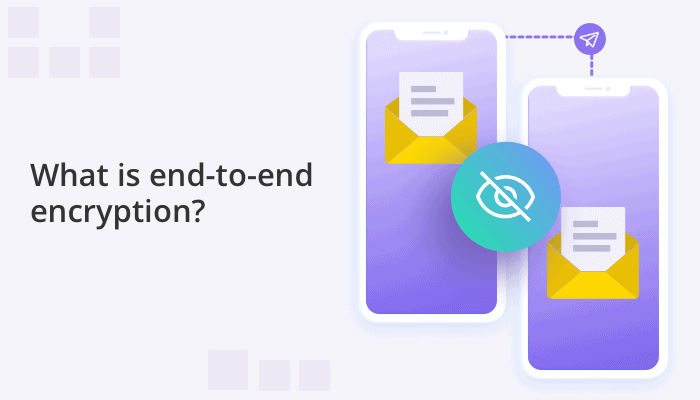
End-to-end encryption is one of the things users look for when they choose a messaging service. This method of protecting communications is designed to ensure message security while it travels from the sender to the recipient.
End-to-end encryption, or E2EE for short, is used in such popular messengers as WhatsApp, Viber, Telegram, and Facebook Messenger. Other messaging services also enable E2EE to guarantee that all communications are safe. The level of security provided by E2EE is relatively high compared to other methods, which makes it a go-to solution for messengers used in such industries as healthcare and finance. Let’s see what end-to-end encryption is about and how it works.
What is end-to-end encryption?
When a messaging service uses E2EE, all messages can be read only by the designated recipient. The message is encrypted and decrypted at the device level, and only the receiving device can decode it. While it travels from the sender to the recipient, no one can decrypt and read it. Even the internet provider or messaging server processing the message cannot access its content.
End-to-end encryption uses cryptographic keys that are only stored at the sender’s and recipient’s devices. These keys can unlock the process of message decryption, thus, no entity can access the message unless they have the key.
How does end-to-end encryption work?
E2EE uses asymmetric cryptography to encode messages when both parties have their own sets of keys to encode and decode messages. In this it is different from symmetric cryptography where the same key encrypts and decrypts the content. The key needs to be passed from the sender to the recipient to open the message.
With asymmetric cryptography, any two entities can send messages to each other without agreeing on a key first. Each of them has their own pair of keys – a public key and a private key. Public keys are shared while private ones are stored securely on the owners’ devices.
When one of the parties sends a message, they use the recipient’s public key to encrypt it. The recipient then uses the corresponding private key to decode and read the message. Such use of two keys instead of one gives an additional layer of security to the communication.
While the message travels from the sender to the recipient, it remains scrambled and unreadable to anyone else.
Pros and cons of end-to-end encryption
As any method or technology, E2EE has its advantages and disadvantages that you should consider when choosing it as a security criterion of a messaging app.
Pros
- Message security in transit. With private keys stored only at the endpoint devices, there is no way to decode the message at any other point. As a result, messages remain secure on the way from the sender to the recipient.
- No need to send the key. Unlike one-key encryption, in E2EE keys need not be sent between the parties. The recipient has their private key already. This way, communication security is higher, as there is no way to intercept the key.
- Regulatory compliance. Regulations governing the handling of sensitive personal data require that communication providers use encryption to ensure data security. While regulations usually do not specifically prescribe the encryption method – for example, GDPR requires encryption leaving the choice of method to the provider, – they state that data needs to be encrypted.
Cons
- Risk at endpoints. With messages encrypted and decrypted at endpoints, if endpoints are compromised in any way, messages may be read by unauthorized entities.
- Metadata remaining unencrypted. The message metadata – date and time of sending, intended recipients, and so on – is not encrypted and may be intercepted. Sometimes, metadata can contain important information that hackers can use.
- Privacy applies to illegal communication, too. When a messaging service implements end-to-end encryption, all messages sent within its system are encrypted. As a result, there is no way for law enforcement agencies to monitor communications to detect criminal or illegal messaging.
Are all messages encrypted?
It depends on the messaging service policies. It is a common practice to use E2EE in direct and group chats. However, messaging providers may not encrypt their communities or channels with E2EE, as it will prevent new members from viewing the channel history.
For the sake of transparency, messaging apps usually show if a particular channel is encrypted or not, so that users can know how they are protected in their communications.
Another case when E2EE is not to be used is payment services support in messenger apps. Many messengers allow payments directly within the chat. However, the actual payments are processed by financial institutions which need access to data to complete the transfer. Therefore, payments are not end-to-end encrypted.
Can you enable end-to-end encryption in a messaging app?
If your messenger supports E2EE, you can choose to enable it for all or some of your contacts. This feature gives you flexible control over your messaging security and allows you to balance it with the regulatory requirements, which is especially important for business customers.
For example, enterprise users of QuickBlox chat can enable end-to-end security on top of the base security measures offered by the QuickBlox chat platform. As a result, some or all communication channels within the QuickBlox-based enterprise network may be encrypted to ensure message security.
Make your messaging secure
While end-to-end encryption is a strong security mechanism protecting message data in transit, it is only one of the methods you can implement. Secure messaging is a complex system that combines protection of both the software and the hardware and regulatory compliance. It needs regular checks and audits, maintenance and updates to ensure that the security measures you apply can withstand the known cyber threats.






